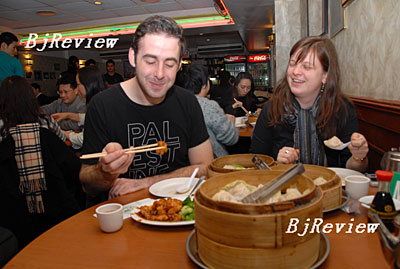|

It's 12:30 p.m. on Tuesday, time for a break from the day's busy work and time for a relaxing lunch with colleagues or friends. Alex Steed and his friend Faith Rose are sitting at a table trying to pick out the most attractive names of dishes from a bilingual menu at a Chinese restaurant in New York City's Chinatown, six blocks away from Steed's office in lower Manhattan.
Rose, a second-time visitor to the restaurant, was there two weeks earlier with a friend and wanted Steed to try it out. "The dumplings here are particularly famous among New Yorkers," Rose told Beijing Review.
So they came for the dumplings, a typical choice of Chinese food among Westerners, and they also ordered Sesame Chicken and Chow Mein, two of the most famous and popular Chinese dishes in America.
Rose and Steed have never been to China, but like other Americans who enjoy trying food from around the world, they have come to know a little bit about Chinese culture through its most famous dishes.
There are now more than 50,000 Chinese restaurants all around America, according to Steven Wong, Chairman of Chinese Restaurant Alliance of the United States, an organization established last year mainly to mitigate disputes between Chinese restaurant workers and the Chinese workers' union.
Over 100 years of history
"Chinese food--'fake' Chinese food, to be more accurate--has a history of over 100 years in America," Wong said, jokingly referring to what people call "Americanized Chinese food," that is food cooked to please the palates of Americans.
Born and raised in Hong Kong, and with family origins in Fujian Province, Wong has lived in the United States for about 37 years. He likes to tell the history of Chinese food in America.
As early as the mid 19th centuries, Chinese immigrants to the U.S. improvised dishes like Chow Mein and Chop Suey, a stir-fried mix of vegetables and meat or seafood, according to their memories of the Chinese food they had eaten before moving to the U.S, Wong said. Those dishes were gradually known and accepted by Americans as Chinese food.
In the 1970s, when China and the U.S. normalized their diplomatic relations, Americans started to experience the "China fever," including a growing interest in Chinese food, he said. At that time, Chinese dishes commonly featured the so-called taste of Hunan Province, the birthplace of Chairman Mao Zedong, and Sichuan Province, famous for spicy food.
"Around 1974, the peak time for Chinese food in America, it was reported that almost every American family visited a Chinese restaurant at least once a week," said Wong.
One of the most famous dishes in America, General Tso's Chicken, is one that many Chinese back in their native land have never heard of, he added. It was introduced in the 1970s by a Hunan-style restaurant. This was the first spicy Chinese dish made for Americans, Wong said.
Americanized or authentic?
When America's largest chain of fast food restaurants McDonald's entered China in the early 1990s, it changed the flavor of its burgers and also created new varieties of food to suit the Chinese taste. This localization strategy has won McDonald's big success in the world's most populous country. But when it comes to Chinese food in America, it's another story.
Typical Americanized Chinese food is cooked with some standard sauces, which are sweet, sour and a bit spicy, featured in well-known dishes like General Tso's Chicken, Sesame Chicken (or beef), Peking Duck and so on, said Perter Liu, a Chinese immigrant from Shanghai who has been working in Chinese restaurants in New York for more than 10 years.
"The Americanized Chinese food is popular in this country mainly because Americans are used to its flavor. Those who have tried authentic Chinese food and those who have studied in China prefer authentic Chinese food or at least food that is much closer to the authentic taste," Wong said.
Steed agreed, adding that he has tried Chinese food in America many times and thought that what he ate was authentic, until then his colleagues and friends coming back from China told him, "That's not Chinese food."
"There is a very homogenous view of what Chinese food is in America," Steed said. Eager to try the real diverse tastes of cuisine from a country with several thousand years of history and 1.3 billion people, Steed said he had difficulties in finding the right restaurant.
There are a lot of Chinese restaurants in the United States today, but few of them serve authentic Chinese food, and most of the chefs in Chinese restaurants are not professionals, Wong said.
For Nina Zagat and Tim Zagat, co-founders of the popular Zagat Restaurant Survey, the current situation of Chinese restaurants in the U.S. is worrisome. In an article they wrote for The New York Times last June, they said, "For American diners, the Chinese restaurant experience is the same tired routine--unimaginative dishes served amid dated, pseudo-imperial décor--that we've known for years."
With an unprecedented number of foreigners going to China to attend the Olympic Games, they may return home demanding authentic Chinese dishes, and the next stage of evolution of one of America's favorite foreign cuisines may begin.
(Reporting from New York) | 